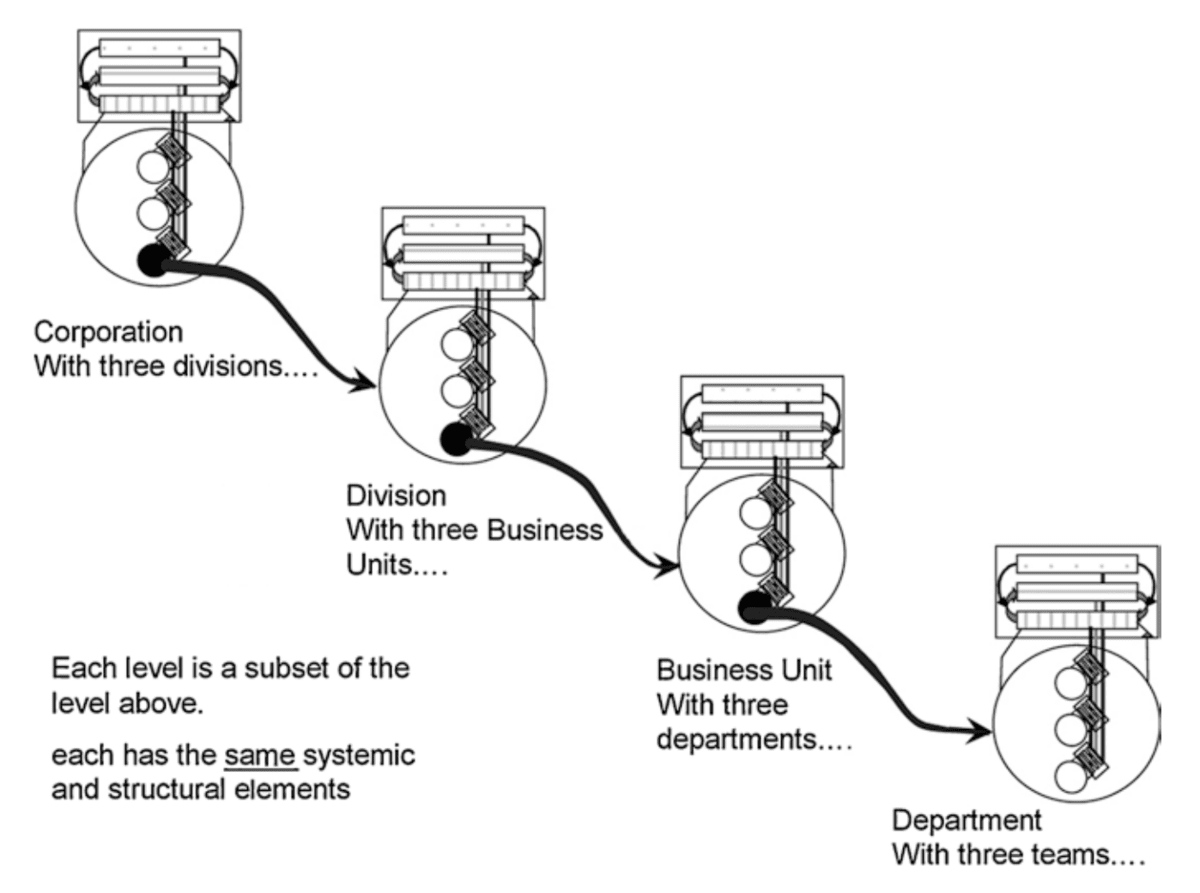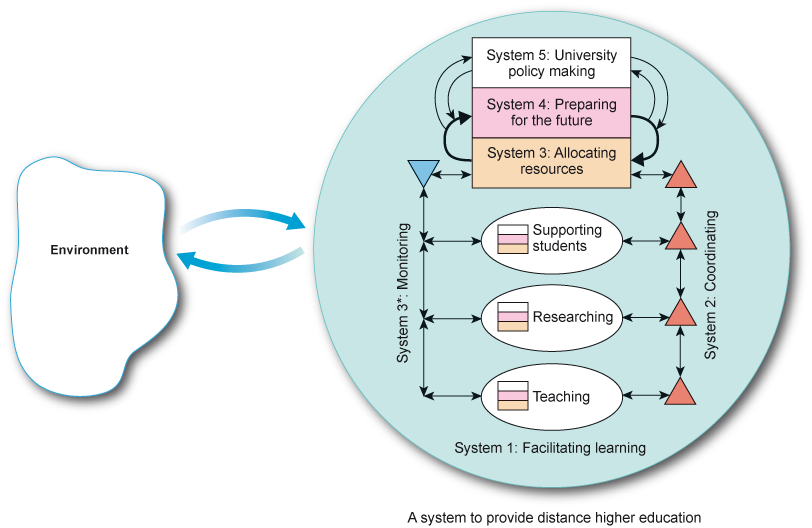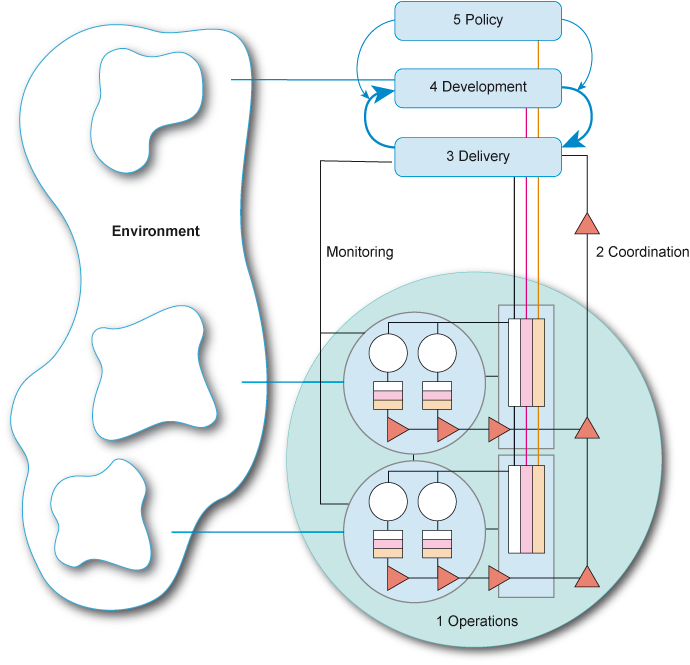TB871: The five systems of the Viable System Model (VSM)
Note: this is a post reflecting on one of the modules of my MSc in Systems Thinking in Practice. You can see all of the related posts in this category.
In my last post, I gave a very high-level overview of the Viable Systems Model (VSM) developed by Stafford Beer. This post is based on my notes from a chapter by Patrick Hoverstadt, an experienced VSM practitioner, in one of the course texts.
One of the key points that Hoverstadt introduces at the start of the chapter is that the internal logic of the VSM is based on the Conant-Ashby Theorem: “every good regulator of a system must be a model of that system.” In other words, this means that your ability to manage an organisation very much depends on how good your model of that organisation is.
Hierarchy isn’t a good model of a system, he points out as, unlike the VSM, it “doesn’t model a number of quite important things you need to know to understand an organisation, such as: what it does, how it does it, how and where performance is managed, how the parts are coordinated, how the organisation adapts, how or where it takes decisions, and on what information those decisions are taken.” (Hoverstadt, 2020, pp.90-91)
Overview of the five systems
The five systems that make up the VSM each has a specific role but must work together to maintain the viability of the overall system:
- System 1: Primary Operations — The core activities or units within an organisation that perform the essential work and produce the primary value for the external environment. Think of these as the operational units directly involved in delivering the organisation’s products or services.
- System 2: Coordination — Consists of the protocols and activities that ensure the different operational units (System 1s) work harmoniously without conflicting with one another. It deals with issues like scheduling, standardising procedures, and ensuring smooth interactions among operational units.
- System 3: Management of Delivery — Concerned with the internal management functions that oversee and control the operations. It includes activities related to allocating resources, setting performance targets, and ensuring that the operational units meet these targets. It acts as the supervisory layer ensuring efficiency and effectiveness.
- System 4: Development and Planning — Focuses on the external environment and future planning. It involves activities related to market research, innovation, strategic planning, and adaptation to changes in the external environment. It ensures the organisation remains relevant and can respond to future opportunities and threats.
- System 5: Governance — Ensures that the organisation as a whole functions cohesively and maintains its identity. It balances the present operational needs (System 3) with future planning (System 4). It deals with high-level decision-making, values, policies, and overall governance to ensure consistency and alignment with the organisation’s goals and principles.
A lot of the language used about the VSM assumes a large organisation, but Hoverstadt does point out that in a small organisation, if one person does different types of activity, the could be performing several of these functions, and active in different areas of the model (ibid., p.92)
Fractal/recursive approach

The reason that VSM is different to a hierarchy is that it is ‘fractal’ — and indeed Hoverstadt’s business is called ‘Fractal Consulting’). A VSM diagram explains activity, so can be nested inside one another: “So, we have viable systems made up of viable systems which are made up of viable systems and all of which use the same systemic architecture” (ibid.,p.92)
One insight which I found quite compelling was Ashby’s Law of Recursive Variety, which states that “only variety can absorb variety.” Here, ‘variety’ means a measure of complexity (i.e. the number of possible states of the system). For example, if the environment demands six services and we can only deliver five, then we don’t have ‘requisite variety’. It’s worth thinking about in lots of different situations I’ve found myself over the years, and in fact the above diagram made me think whether the VSM could be used instead of, or alongside, OKRs?
Autonomy & cohesion
Some people have said that VSM is a way of justifying hierarchy, whereas others have suggested that VSM is anti-hierarchy. Hoverstadt says that both are wrong, and VSM is all about a critical balance which he calls ‘cohesion tension’:
Too much autonomy and all cohesion – the wholeness is lost. Too much cohesion, too little autonomy and emergence is reduced and “wholeness” is impoverished.
(Hoverstadt, 2020, p.93)
Hierarchy is about power and control, whereas VSM is about managing complexity and difference, and gives organisations the language to be able to achieve this.
System 1: Primary Operations
System 1 is about “understanding the business we are in” and constitutes the primary activities of the organisation. Within this, there are four principal drivers of complexity:
- Technology: different tasks or specialisations within the organisation (e.g. in a building company, plumbing is different from bricklaying)
- Geography: structuring the organisation based on location (e.g. different teams working on separate building sites or different offices in various cities)
- Customers: organising activities according to customer types (e.g. an accountancy firm with a team for big accounts and another for small clients)
- Time: ensuring the job continues beyond what a single individual or team can handle in one go (e.g. 24-hour services like emergency services)
Hoverstadt goes into some detail about how organising primary activities differently can lead to different advantages, disadvantages, and outcomes. TL;DR this stuff is complex and doesn’t always work as you’d expect.
System 2: Coordination
The more autonomy that is granted to people or teams performing the primary operations in System 1, the more coordination we need to ensure everything works harmoniously. The need for this coordination increases due to three factors:
- Number: more activities mean more need for coordination.
- Interdependence: the more these activities depend on or impact each other, the greater the need for coordination.
- Environment: the more these activities affect the same external environment, the higher the need for coordination.
A failure of coordination (“absence of coordination mechanisms”) is one of the three most common systemic problems seen when diagnosing organisations (ibid., p.107).
Wherever a message crosses a system boundary: between two individuals, two departments or two companies, it undergoes “transduction” a process of translation in which it inevitably gets changed to some extent. The distortion can be trivial or critical, but the purpose of creating common languages is to build effective transducers that reduce distortion as far as possible.
(Hoverstadt, 2020, p.109)
Hoverstadt doesn’t explain ‘transducers’ so I had to look them up. GPT-4o explained them to me as “a mechanism that converts information from one form or language into another to facilitate communication between different parts of the system”. For example, a business unit might translate raw sales data (input) into a summary format (output) that management can use for decision-making.
System 3: Management of Delivery
The structure of value creation breaks the organisation down, operational level by operational level and provides the basic seed structure for the viable system (Hoverstadt 2008; Beer 1985). The essential function of line management is to build these component operations back up into a cohesive coherent organisation that can create synergy.
(Hoverstadt, 2020, p.110)
The purpose of management is to provide organisational cohesion between various operational activities, usually through providing resources and monitoring performance. As Hoverstadt mentions, and as most people know, this is often done particularly badly. In fact, he mentions that “typically between 20% and 30% of senior manager’s time” is taken up with planning and budgeting (ibid., p.112).
While measuring performance is crucial, many organisations make performance measures too generalised, making the management job much more difficult. In addition, problems of over-resourcing or under-resourcing are common. The ‘control dilemma’ helps explain this: management requires increasing levels of performance reporting as it is worried about a loss of control over operations. This breeds distrust, when what they should be doing instead is ‘monitoring’ (ibid., p.114).
Monitoring (usually qualitative) is distinct from performance measuring (usually quantitative) as it is:
- Sporadic: prevents staff from feeling constantly watched and avoids heavy-handedness.
- Unannounced: ensures the true state of affairs is observed, preventing ‘window dressing.’
- Skips a level of management: provides a realistic view of the organisation and prevents management from relying solely on reports.
- In depth: thoroughly examines operations to uncover any hidden issues or unsavoury practices.
System 4: Development and Planning
The purpose of System 4 is to ensure a healthy fit between the organisation and its environment. “In other words it has to ensure that the organisation is doing the right things and able to maintain some sort of value exchange with its environment so that it can remain viable into the future” (ibid., p.115)
This is done by performing five different roles:
- Scanning the external environment for changes or potential future changes and
specifically scanning for strategic risks - External communications (other than those directly related to operations)
- Innovation
- Managing change
- Building and holding the organisation’s model of itself
These all sound like something that my organisation does, and that I enjoy doing! It’s a critical role because, as Hoverstadt states, the failure rates of commercial organisations are evidence of just how common issues failures or weaknesses with System 4 sub-systems are.
When this sub-system is weak, disconnected, or missing entirely, there are both passive and active problems:
- Passive problems: organisations can’t anticipate changes, are surprised by them, can’t adapt, and fail without innovation or self-change.
- Active problems: weak or missing System 4 leads to failure in creating changes, causing relationships with the environment to deteriorate, making large, complex systems vulnerable and prone to collapse quickly.
Hoverstadt provides a list of symptoms of System 4 failure. These include creating new products with no markets for them, failing to adapt to changing technology, and persisting with outdated products. This isn’t just a commercial risk, it’s common within the NGO and charity sector too, with interventions that can’t be ‘sold’ to intended users (ibid., p.117)
Change programmes often fail, and the often-quoted figure is a failure rate of around 80%. This is due to an issue that all of us will recognise: resistance to change. But it is also due to boundary issues that become “the grit in the change process that creates friction and drives resistance” (ibid., p.117). It is very unlikely that the different parts of an organisation will all move at the same speed, and so friction can lead to failure.
VSM works differently, using a ‘mosaic’ approach:
A VSM based approach to organisational transformation approaches the problem in quite a different way. It involves breaking change down into discrete, “do-able” packets and introducing these in a sequence of planned initiatives. These allow managers to concentrate on changing elements of the organisation in a discrete way, whilst managing the interfaces between that element and the rest of the organisation
(Hoverstadt, 2020, p.118)
so that change is not prevented by resistance through boundary issues. The sequence of change needs to be planned so that each stage helps prepare for subsequent changes either by creating structural redundancy (often in the form of management time released from fire-fighting) or by removing structural obstacles to subsequent changes.
The two key elements in this mosaic approach to system transformation are:
- Structural redundancy: Having spare capacity in the system allows for change. The amount and rate of change depend on the availability of these extra resources.
- Discrete packets of change: Change components and their direct interfaces incrementally, rather than changing everything at once, to manage resources effectively and ensure successful transformation.
Using the VSM model as a diagnostic and as a design tool allows a current and future state of the organisation to be mapped. Comparing these two maps shows which parts of the organisation will be directly affected, and how one change might affect another.
The next step is deciding where to start the change, bearing in mind that the change must be ‘practicable’ and ‘worthwhile’. Factors that affect this include everything from group cohesion to quality of leadership and resources available to assist change. Making an assessment based on various factors can be a complex decision, but the most important thing is judgement based on what Hoverstadt (2020, p.119) calls two ‘hard rules’:
- Match change with resources: ensure proposed changes align with the available resources to avoid management overstretch.
- Follow natural progression: recognise the interdependency of changes, ensuring ‘A’ is changed before ‘B’ to maintain a logical sequence.
System 5: Governance
System 5 is about identity and cohesiveness. It exists to do three distinct but related things (ibid., p.127):
- Governance role: ensures the organisation functions as a self-managing system and maintains a healthy fit with its environment, even if it involves dissolving the organisation.
- Identity management: creates, maintains, or recreates the identity of the organisation.
- Relationship understanding: maintains an understanding of the relationship between the system-in-focus and the larger system in which it is embedded.
When these roles are working well, they’re nearly invisible. When governance fails, an organisation can disintegrate. The most sensitive areas are balancing ongoing operations with development and monitoring performance. If these areas are neglected, the organisation is likely to fail when facing challenges. This can lead to a “Death Spiral.”
The problem begins with governance failing to balance strategic decision-making and address external and future factors. Environmental changes go unnoticed, causing erratic operational responses. This leads to instability within units and excessive intervention by higher management, reducing the organisation’s responsiveness.
As management enters crisis mode, their ability to address issues diminishes, isolating them from external information. At this point, the organisation can only be saved by external intervention or a favourable environmental change, making survival a matter of luck. The root cause is a failure of governance.
Hoverstadt says that he uses two different approaches when building a VSM, a conventional one based on the mnemonic TASCOI, and one based on ‘structural coupling’ (ibid., p.126).
TASCOI is based on stakeholder relationships and defines the organisation’s purpose as being what the system actually does. Hoverstadt uses this when designing a new system or when problem-solving:
- T = Transformation, what the system changes from what into what
- A = Actors, those carrying out the transformation
- S = Suppliers to the transformation process
- C = Customers, those in receipt of the transformed product
- O = Owners, those responsible for ensuring it happens
- I = Interveners, those with an interest in the process
In any other situation, he uses structural coupling. Using this approach, “the organisation is defined as a system that has a set of relationships with different parts of its environment in which some value exchange happens which affects the structure of activities (in other words causes you to do something different)” (ibid., pp.126-127). As a result, you model the same organisation from multiple viewpoints at the same time, giving a more rounded model.
Ultimately, the VSM is a conceptual model, and not a methodology:
What we are actually looking at is how the organisation reconciles the fact that the environment is more complex than itself and that its operations are more complex than management. Each of these complexity equations has a dynamic or expresses a dynamic tension. If we can maintain requisite variety, we have some degree of order, if we don’t have requisite variety then we have chaos. In the terms used by complexity theorists, Ashby’s law defines the edge of chaos and what the VSM models is the organisation’s ability to walk the edge of chaos. It’s very far from being a static model.
(Hoverstadt, 2020, p.131)
There is, of course, an ethical dimension to all of this. “As you go up levels of recursion, you go up levels of logical concern,” says Hoverstadt, meaning that “What may seem appropriate at one level may seem very inappropriate when viewed from a different level even within the same system.” As such, the VSM can be useful for predicting and modelling ethical issues (Ibid., p.135)
Final thoughts
There are, apparently, at least two alternative graphical representations of the VSM, but I couldn’t find them. I do agree that the complexity of the diagram would put me off, especially as it doesn’t fit nicely on a slide (which is one of my key factors when trying to explain things to people).
I can see how the VSM approach could be useful, and look forward to trying to apply it in my area of interest. Right now, it seems a little bit technical, and somewhat more focused on larger organisations, but I’m willing to give it a try!
References
- Hoverstadt, P. (2020). ‘The Viable System Model’. In Reynolds, M. & Holwell, S. (eds.) (2020). Systems Approaches to Making Change: A Practical Guide. London: Springer, pp.89-138.
- The Open University (2020) ‘3.1.1 Dynamic organisational design’, TB871 Block 3 Tools stream [Online]. Available at https://learn2.open.ac.uk/mod/oucontent/view.php?id=2261487§ion=2.1 (Accessed 14 June 2024).





